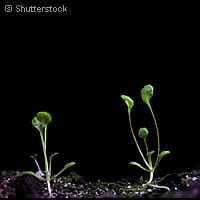Scientists investigate physical traits in plant inbred lines
Geneticists have given the plant world a boost by developing a new method to locate genes behind physical traits in plants. Funded in part by the EU, the scientists believe this first extensive use of genome-wide association (GWA) in a plant species could help scientists determine important agricultural traits including disease resistance and biomass production. The findings of this groundbreaking study are presented in the journal Nature. The research is part of the ANAVACO ('Analysis of natural variation for cold tolerance in the model plant species Arabidopsis thaliana') project, which has received more than EUR 236,000 under the People Theme of the EU's Seventh Framework Programme (FP7). ANAVACO, which kicked off in 2008 and is schedule to end in 2011, aims to identify the genes underlying variation for cold tolerance in A. thaliana. In the Nature study, the researchers, led by the University of Southern California (USC) in the US, say the developed model could benefit the agriculture and biofuels fields. The team investigated natural variation in 107 different traits in almost 200 strains of A. thaliana, a self-fertilising model plant that is known for its ability to harbour considerable genetic variation for many key traits. Their work allowed them to check the genome for mutations at many more points, they say. 'The useful applications to agriculture, biofuel production and potentially changing and challenging plant growth conditions are vast,' explains co-first author Dr Susanna Atwell from the USC College of Letters, Arts and Sciences. 'This data set and methodology holds the potential to determine genes involved in natural variation in metabolite levels, biomass, flowering time, salt or heavy metal tolerance and disease resistance, to name but a few.' By comparing the genomes of A. thaliana at 250,000 pre-selected locations, the researchers successfully identified parts of the genome that may contain genes responsible for the phenotypic variation they observed. According to the researchers, because it is not 100% sure that the gene identified is behind a particular trait, more testing is needed of genes that were uncovered through genome-wide association. The researchers are already assessing some 60 previously unknown genes to substantiate their predicted function. 'GWA mapping is a faster method for locating causal genes as the genes are located to a smaller region than previously mapping techniques I have used,' Dr Atwell points out. 'Our data set does a good job of locating previously known ones, so we have confidence that the novel genes that are also identified will also be real.' Dr Atwell goes on to say that she believes the study will become a major resource for the some 5,000 geneticists currently investigating A. thaliana around the globe. Key contributors in this study were more than 30 researchers from Université des Science et Technologies de Lille (France), the Max Planck Institute for Developmental Biology (Germany), the Gregor Mendel Institute (Austria), the John Innes Centre (UK), the Sainsbury Laboratory (UK), the University of Chicago (US), Purdue University (US), the Howard Hughes Medical Institute (US) and The Salk Institute for Biological Studies (US).
Countries
Austria, Germany, France, United Kingdom, United States



